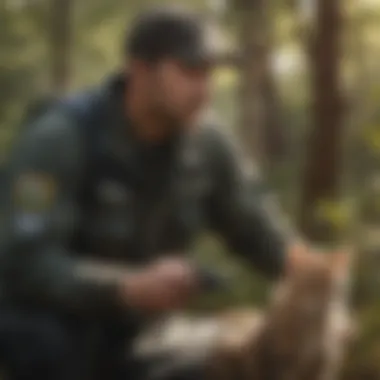Understanding the National Wildlife Control Operators Association


Intro
In a world where nature often collides with human existence, the need for effective wildlife control has blossomed into a necessity. This article takes a deep dive into the National Wildlife Control Operators Association (NWCOA), an organization that plays a cornerstone role in ensuring that wildlife management is done ethically, effectively, and with a keen sense of ecological responsibility.
Through this piece, we aim to illuminate the vital functions and contributions of the NWCOA in wildlife management, offering readers insights into their objectives, functions, and standards promoted in wildlife control practices across the United States. By addressing their training protocols, ethical standards, and innovative pest management solutions, we hope to shed light on how the association enhances the professionalism and efficacy of wildlife control operators.
The following sections will present a structured exploration focusing on the core themes surrounding the NWCOA’s role, leading into an understanding of pests and effective management techniques that keep our living spaces harmonious with nature.
Preamble to the National Wildlife Control Operators Association
In the ever-evolving realm of wildlife management, the National Wildlife Control Operators Association (NWCOA) stands as a beacon of knowledge and professionalism. Established to address the complex challenges surrounding wildlife control, this organization plays a pivotal role in shaping standards, practice, and education within the profession. The NWCOA doesn’t just advocate for its members; it sets a framework that benefits the broader community, ensuring that wildlife management is conducted ethically, effectively, and humanely.
Foundational Principles
The heart of the NWCOA lies in its foundational principles, which guide its actions and decisions. These principles emphasize the necessity of humane approaches to wildlife control, acknowledging the intricate balance between human needs and animal welfare. It underscores the importance of responsible management practices, aiming to provide solutions that are not only effective but also socially acceptable and environmentally sound.
These principles serve as a compass for wildlife control operators, ensuring that their methods align with the values of accountability and stewardship. By fostering respect for both wildlife and human interests, the NWCOA positions itself as a significant player in promoting a sustainable future for wildlife management.
Mission Statement
The mission statement of the NWCOA succinctly encapsulates its commitment to excellence in wildlife control. It strives to establish a standard that operators across the nation can aspire to; a covenant of professionalism that champions ethics, continuous improvement, and the sharing of best practices.
"To promote ethical, sustainable, and scientifically sound wildlife control solutions."
This mission highlights not only the organization’s focus on ethical practices but also its dedication to education and training. By fostering a culture of learning, the NWCOA equips its members with the necessary tools to confront the challenges posed by wildlife interactions. It recognizes the importance of ongoing education and adaptation to new developments in wildlife behavior and management strategies.
Through these guiding statements and principles, the NWCOA shapes the narrative around wildlife control, aiming to cultivate a community that values expertise and humane treatment of wildlife. Whether it's a homeowner seeking to address a skunk under the deck or a family faced with a raccoon rummaging through trash, the NWCOA stands ready to provide resources and guidance, ensuring that both human and wildlife concerns are met with care and professionalism.
Historical Context
Understanding the historical context of the National Wildlife Control Operators Association (NWCOA) is crucial to grasping its significance today. The organization arose out of necessity—the need for a structured approach to wildlife control in situations where human encroachment increasingly affected both urban areas and wildlife habitats. The initial gap in wildlife management practices paved the way for the association's establishment. This history not only contextualizes the NWCOA's mission but also reflects the ever-evolving relationship that communities have with wildlife.
Origins of the NWCOA
The dawn of the NWCOA can be traced back to the late 20th century, a time when wildlife populations began to shift due to urban expansion and changes in land use. Professionals in pest control realized there wasn't a unified body advocating for standards in wildlife management. In response, a handful of pioneers in the field collaborated to form the organization, formally known as the NWCOA, around the early 2000s.
These initial members, recognizing the need for a code of conduct, sought to provide technical and ethical guidance in wildlife management. The incorporation of diverse professionals, including trappers, wildlife specialists, and pest management experts, initially drove the association's focus.
Evolution Over Time
As years went by, the NWCOA adapted to the shifting landscape of wildlife control. Various external factors prompted this evolution, notably changes in laws and increased public scrutiny, spurring a demand for better practices.
For instance:
- Legislation: The US had various local and federal regulations impacting wildlife management. The association took steps to ensure its members were well-informed about these laws and how to navigate them effectively.
- Public Perception: With growing awareness and concern for animal welfare, the NWCOA shifted its focus to emphasize humane methods in wildlife control. Addressing this public sentiment not only improved the credibility of wildlife control operators but also reinforced the need for ethical practices within the industry.
- Training and Certification: What began as loose affiliations between wildlife control operators evolved into structured training programs instituted by the NWCOA. These programs laid the groundwork for certification, giving operators the tools to handle wildlife situations ethically and effectively.
"The NWCOA’s ability to evolve in response to environmental and societal changes demonstrates its commitment to sustainable wildlife management practices."
Ultimately, the historical progression of the NWCOA underlines the essential role of structured industry practices for the proper handling of human-wildlife conflicts. This context sets the stage for understanding the present workings of the association, its objectives, and its influence on wildlife management standards.
Objectives of the NWCOA
The National Wildlife Control Operators Association aims to set a standard for wildlife management in America. Its pivotal objectives not only enhance the skills of professionals in the field but also protect communities from wildlife-related issues. With a solid foundation, the association addresses pressing concerns ranging from ethical practices to effective wildlife management strategies. Understanding these objectives is crucial for anyone involved in wildlife control or pest management because it influences how operations are conducted across various regions.
Wildlife Management Standards
Establishing robust wildlife management standards stands at the forefront of the NWCOA’s objectives. These standards serve as a roadmap for operators, guiding them to conduct their work effectively and humanely. The importance of these guidelines cannot be overstated; they ensure that wildlife control is performed responsibly, minimizing the distress caused to animals while addressing human concerns. This balance is essential, for it fosters a community's trust in wildlife operators.
Furthermore, these standards include protocols for species identification, trapping, and removal techniques, which must adhere to state and federal regulations. Operators who follow these established norms not only safeguard themselves legally but also bolster the ethical treatment of wildlife in their care. The guidelines are regularly reviewed and updated, reflecting the latest knowledge and practices in wildlife management, thereby keeping operators informed and effective in their roles.
Professional Development
Professional development is another critical objective of NWCOA, aimed at enhancing the skills of wildlife control operators. Continuous training and education are vital in this ever-evolving field. By offering various courses, workshops, and certification programs, the association ensures that operators stay updated with new technologies, methods, and regulatory changes.
Taking part in these initiatives boosts operators’ confidence and competence. It’s often said that an informed operator is a successful operator; hence, the emphasis on ongoing education cannot be ignored. Homeowners and communities benefit from working with well-trained professionals, resulting in efficient problem-solving without unnecessary complications.


In addition to practical skills, professional development encourages operators to network and share insights with their peers. Engaging with others in the field fosters collaboration, providing a deeper understanding of challenges faced in wildlife control.
Advocacy and Representation
Lastly, advocacy and representation is an essential pillar of NWCOA's objectives. The association not only speaks on behalf of its members but also champions sound policies concerning wildlife control practices at the state and national levels. This advocacy is vital in shaping legislation that impacts the profession, ensuring that laws reflect the realities and necessities of humane wildlife management.
By engaging with policymakers and providing data-driven insights, NWCOA reinforces the significant role wildlife control operators play in maintaining a balanced ecosystem. This representation also helps to educate the public about the complexities of wildlife management, dispelling myths and promoting best practices. Ultimately, a well-informed public results in greater support for professional wildlife control efforts, making communities safer and more harmonious.
"Advocacy isn’t just about speaking for oneself; it’s about creating a collective voice that can influence change."
Together, these objectives—wildlife management standards, professional development, and advocacy—offer a comprehensive framework that underscores the significance of the NWCOA and its members in ensuring safe and effective wildlife control.
Core Initiatives and Programs
The National Wildlife Control Operators Association (NWCOA) undertakes a range of core initiatives and programs that not only enhance the skill set of wildlife control operators but also ensure that wildlife management practices are upheld to high professional standards. These programs are pivotal in shaping the dynamics of the industry, creating a pathway for operators to work efficiently while honoring ethical and sustainable practices. It’s through these programs that NWCOA solidifies its reputation as a trusted authority in wildlife control.
Certification Programs
Certification programs provided by NWCOA serve as a cornerstone for establishing credibility among wildlife control professionals. These programs ensure that participants are rigorously trained and tested on industry standards, regulations, and latest methodologies. When an operator earns a certification, it’s not just a piece of paper; it symbolizes a commitment to quality, safety, and ethics in wildlife management.
Operators can choose from a variety of certifications that focus on different aspects of wildlife control, such as trapping, exclusion, and handling hazardous wildlife. This specialized training addresses the multifaceted challenges wildlife control professionals face daily, from managing animal behavior to understanding local laws governing wildlife protection. It further strengthens the operator’s position as a reliable source for homeowners seeking assistance in managing wildlife nuisances in their properties.
Continuing Education Opportunities
In an ever-evolving field like wildlife control, staying updated with the latest advancements is crucial. NWCOA offers a plethora of continuing education opportunities that empower wildlife control operators to keep their knowledge fresh and relevant. These opportunities encompass workshops, seminars, and online courses covering topics from the latest trapping technology to advanced animal behavior studies.
Through these educational avenues, operators can refine their skills, learn about modern pest management techniques, and understand environmental impacts more deeply. This ongoing education is particularly vital as public awareness about humane wildlife control grows. Homeowners appreciate professionals who can articulate their methods and the reasoning behind them, fostering trust and a sense of responsibility in wildlife management.
Research and Development
Research and development stand as the bedrock upon which best practices are established. NWCOA prioritizes research initiatives that aim to discover innovative solutions and strategies for wildlife management, addressing current and emerging issues in the discipline. By focusing on practical research, the association helps operators implement evidence-based methodologies that enhance effectiveness without compromising safety or ethical standards.
Collaborating with academic institutions, wildlife biologists, and conservation organizations, NWCOA spearheads projects that investigate everything from species behaviors to the socio-economic effects of wildlife management on communities. These insights guide operators in making informed decisions about the techniques and approaches they employ while working in the field. More than just adhering to the status quo, NWCOA encourages operators to challenge conventional practices and seek out progressive strategies that align with the values of today’s wildlife stewardship.
"The NWCOA is not just about controlling wildlife; it's about fostering a harmonious relationship between humans and the natural world."
By endorsing these core initiatives and programs, the NWCOA positions itself as not just a regulatory entity but as a proactive advocate for responsible wildlife management. The commitment to certification, continuing education, and rigorous research ensures that wildlife control operators are well-equipped to navigate the complexities of modern pest management while promoting sustainable practices that protect both wildlife and human interests.
Such comprehensive support not only uplifts individual operators but ultimately enriches the broader community, creating a more informed public about wildlife issues.
Training and Professional Standards
Training and professional standards form the backbone of effective wildlife management. For individuals involved in wildlife control, knowledge is power. Without proper training, operators might face challenges that could escalate issues rather than solve them. The National Wildlife Control Operators Association emphasizes a structured approach to training that benefits not only the professionals themselves but also the communities they serve.
Importance of Training
Engaging in rigorous training equips wildlife control operators with a wealth of skills and information necessary for safe and effective practices. For example, consider how a trained operator can identify a raccoon's behavior compared to that of a groundhog. Understanding species-specific behavior allows them to implement tailored control methods that are both ethical and efficient.
Some crucial elements of training include:
- Species identification: Being able to accurately identify various species helps in choosing the right approach and equipment.
- Control techniques: Operators learn humane and effective methods to manage wildlife populations, ensuring they cause minimal harm to both animals and the environment.
- Safety protocols: Training covers essential safety measures, protecting both the operator and the public during wildlife control activities. This includes handling equipment properly and understanding potential health risks.
Training also instills a sense of confidence in operators. When they're equipped with the right skills, they can approach their work with the assurance that they're making informed decisions, leading to better outcomes for everyone involved.
Ethics in Wildlife Control
Ethics in wildlife control can not be overstated. The NWCOA emphasizes that operators must not only act within the law but also consider the well-being of the wildlife they manage. This ethical framework helps to mitigate negative perceptions of wildlife control professionals. For instance, ethical wildlife control might mean prioritizing non-lethal methods or seeking rehabilitation for animals whenever possible, instead of resorting to extermination.
Several key ethical considerations include:
- Humane treatment: Wildlife operators must strive to handle situations in a way that causes the least amount of suffering to animals.
- Respect for ecosystem balance: Understanding the role each species plays in the ecosystem is crucial. Ethical operators engage in practices that do not disrupt the natural order or balance.
- Community responsibility: An ethical wildlife control operator recognizes their role extends beyond just managing pests; they serve their communities by promoting awareness and education on wildlife coexistence.
"A strong ethical foundation not only guides operators but also builds trust within the community, fostering partnerships that enhance wildlife management efforts."
Ultimately, combining proper training with a strong ethical stance creates professionals who are well-respected and trusted. This synergy enhances the overall effectiveness of wildlife control practices, leading to better results for both human and wildlife populations.


Regulatory Environment
The regulatory environment surrounding wildlife control is vital for maintaining a balanced approach between human activities and wildlife conservation. This encompasses a series of laws and regulations that govern how wildlife management is conducted, ensuring that practices are not only effective but also ethically sound. For property owners, an understanding of these regulations can significantly enhance the way they interact with wildlife, especially during human-wildlife conflicts. Legal compliance not only protects individuals but also ensures the sustainability of wildlife populations.
State and Federal Regulations
At both the state and federal levels, regulations are crafted to provide a framework for how wildlife control should be approached. This means that each state may have differing rules about what is permissible when dealing with wildlife issues. For instance, some states require specific licensing for wildlife control operators, while others might have restrictions on certain methods of animal capture or euthanasia.
- Licensing Requirements: Depending on the state, licenses may be necessary to perform wildlife control. This ensures that operators are trained and knowledgeable about local fauna and the regulations governing their management.
- Protected Species: Certain species are protected under federal law, and interfering with these animals can lead to severe penalties. Understanding which species fall under this category is crucial for homeowners who may encounter wildlife issues.
- Pesticide Regulations: The use of pesticides, especially in wildlife control, is tightly regulated. Operators must comply with regulations set forth by agencies like the Environmental Protection Agency to ensure safety and environmental protection.
These layers of regulation create a complex landscape, but they exist to safeguard both the public and wildlife. As house owners face increasing wildlife encounters, familiarity with these regulations can lead to more effective management solutions.
Impact on Wildlife Control Practices
The impact of regulations on wildlife control practices cannot be overstated. They serve as a guiding principle for how professionals operate, which, in turn, affects community perceptions about wildlife management.
- Ethical Standards: With a strong emphasis on ethical treatment of animals, regulations require wildlife control operators to utilize humane methods whenever possible. This shapes the approach industry professionals take when managing problems, often leading to the use of non-lethal deterrents or relocation efforts rather than extermination.
- Continued Education: Regulatory bodies often mandate continuous education for wildlife control professionals, ensuring they remain informed about best practices and advancements in wildlife management techniques. This not only benefits the practitioners but also impacts the community positively by providing a more knowledgeable workforce.
- Public Health Considerations: Regulations consider public health as well. By managing wildlife effectively, the potential for zoonotic diseases—those which can be transferred from animals to humans—is significantly reduced.
Proper adherence to wildlife control regulations not only benefits homeowners but also ensures a sustainable approach to wildlife management for future generations.
Community Engagement and Outreach
Community engagement plays a pivotal role in the operations and success of the National Wildlife Control Operators Association. It is about more than just building a network of professionals; it’s about fostering relationships with the public, wildlife enthusiasts, and local organizations. Through effective outreach, the NWCOA can bridge gaps in communication, educate the public on wildlife issues, and promote responsible practices in wildlife management. This proactive approach not only enhances the association's reputation but also nurtures trust within communities.
Engaging with the public has many benefits. It can lead to increased awareness about human-wildlife conflicts and the methods that can be employed to mitigate them. This is particularly important in neighborhoods where wildlife encroachment is common. For instance, some house owners may find themselves unaware of the appropriate steps to take when dealing with raccoons rummaging through trash or skunks making homes underneath decks. Public awareness campaigns can help educate them on simple measures to deter these animals humanely.
Additionally, community engagement can result in more comprehensive solutions. When residents feel informed and included, they're more likely to be supportive of wildlife control practices and initiatives. By actively involving the community, the NWCOA can gather valuable insights into local wildlife challenges, making their programs more relevant and effective.
Public Awareness Campaigns
Public awareness campaigns serve as a crucial component in the NWCOA’s efforts to educate the community. These campaigns can take many forms, from local workshops to social media initiatives. The goal is to disseminate accurate information on wildlife management, emphasizing the importance of humane practices.
Considered efforts, like the use of social media platforms or community bulletin boards, can dramatically enhance visibility. These platforms allow the NWCOA to share real-time updates, tips, and success stories about wildlife management. Common campaigns might focus on:
- Ways to secure food sources that attract wildlife
- Information on legal regulations regarding wildlife control
- Resources available for homeowners dealing with wildlife issues
- Highlighting success stories from the community that demonstrate the positive effect of humane wildlife management
Through these types of campaigns, the NWCOA builds a foundation of trust and authority. The more knowledge the public has, the better equipped they will be to handle situations involving wildlife.
Collaboration with Other Organizations
Collaboration with other organizations is another crucial facet of the NWCOA's outreach efforts. Partnerships can significantly amplify the reach and impact of wildlife control initiatives. By working alongside environmental groups, local governments, and educational institutions, the NWCOA can foster a more sustainable approach to wildlife management.
Joint initiatives can take many shapes, such as educational programs run in collaboration with schools or community workshops hosted jointly with local environmental clubs. This kind of teamwork promotes an understanding of wildlife management as a shared responsibility among various stakeholders.
Some specific collaborations could include:
- Local governments: Working together to develop comprehensive wildlife plans that align with regional needs.
- Educational institutions: Offering internships or volunteer opportunities for students interested in wildlife management and conservation.
- Environmental groups: Creating campaigns focused on the benefits of wildlife in urban settings and promoting coexistence rather than conflict.
Partnering with other organizations not only enriches the resources available to the community but also bridges the gap between different stakeholders. Together, they can work towards sustainable solutions that reflect the complex relationship between humans and wildlife.
By using community engagement and collaboration, the NWCOA is shaping a future where humans and wildlife can coexist harmoniously.
Future Trends in Wildlife Control
Understanding future trends in wildlife control is pivotal for several reasons. As urban development expands, the interactions between humans and wildlife invariably increase, leading to more conflicts. This, combined with environmental concerns and the rising significance of ethical wildlife management, ensures that wildlife control must evolve in response to these pressures. Therefore, keeping abreast of advancements can not only help operators manage their practices effectively but also prepare home and property owners for a responsible approach when dealing with wildlife-related issues.
Technological Advances
In the sphere of wildlife control, technology is a gamechanger. From the use of drones for monitoring wildlife in remote areas to smart traps that send notifications to operators when they catch an animal, the advancements are impressive. Technology aids in minimizing the fuss and helps operators carry out their tasks more efficiently.
Here are some notable technological trends:
- Drones: They enable better surveying of larger areas, offering a cost-effective and efficient means to monitor wildlife populations and identify potential problem areas before they escalate. Instead of sending a team out for a routine check, operators can now observe through aerial footage.
- Remote Cameras: These devices capture images or videos of wildlife, allowing for real-time monitoring and risk assessment, which is invaluable for planning intervention strategies.
- Mobile Apps: For instance, apps can help operators log sightings, track wildlife activity, or connect with colleagues in the field. These improvements streamline operations and foster communication, which is vital in this line of work.
The integration of these technologies is not just a nice-to-have; it enables wildlife control operators to anticipate issues before they arise and manage their resources more effectively, hence benefiting homeowners who prefer proactive measures.


Sustainability in Wildlife Control
Sustainability is an increasingly pressing topic in wildlife control. The relationship between human activities and wildlife is very delicate—one misstep can endanger species or disrupt local ecosystems. Therefore, implementing sustainable practices is not merely advisable but necessary.
Key considerations in the sphere of sustainability include:
- Eco-Friendly Methods: Instead of relying on harmful chemicals that may have long-lasting impacts on both wildlife and the environment, operators are exploring more humane ways of controlling animal populations. Solutions like habitat modification or the use of natural repellents are gaining traction.
- Public Education: Informing the public about habitat preservation plays a significant role. This involves educating homeowners on how to make their properties less attractive to wildlife by removing food sources or securing garbage bins. It's a shared responsibility.
- Collaboration with Environmental Groups: Wildlife restoration and conservation organizations are joining hands with NWCOA. This partnership creates a comprehensive approach that emphasizes the significance of sustainable practices in wildlife control.
As these sustainable methods gain ground, they not only help protect the environment but also assist communities in establishing healthier, balanced relationships with the wildlife around them.
"Adapting to future trends is not just prudent; it's essential for effective wildlife management that respects both the natural world and the needs of human society."
In sum, recognizing and integrating these future trends in wildlife control is crucial for operators and property owners alike. Preparing for technological advancements and embracing sustainability will lead to smarter wildlife management that benefits everyone involved.
Challenges Facing Wildlife Control Operators
Wildlife control operators navigate a complex landscape filled with various challenges that can impact their work. Understanding these challenges is vital, as they directly influence the effectiveness of wildlife management strategies. In this section, we'll delve into two significant hurdles: human-wildlife conflicts and resource limitations.
Human-Wildlife Conflicts
Human-wildlife conflicts are an age-old issue that continues to pose significant challenges for wildlife control operators. As natural habitats become more developed, wild animals increasingly encroach on human spaces. This overlap can lead to a host of problems, from minor disturbances to serious threats to property,
and even personal safety. For instance, raccoons rummaging through garbage bins may seem harmless, yet they can pose serious health risks, given their potential to carry diseases. Similarly, deer wandering into urban areas can cause traffic accidents, leading to injuries and sometimes fatalities.
The importance of addressing these conflicts cannot be overstated. Operators play a crucial role in mitigating these issues by utilizing a variety of strategies.
- Public Education: Offering workshops to teach homeowners how to secure their properties against wildlife intrusion.
- Non-lethal Methods: Adopting humane deterrents, such as motion-sensor lights, noise devices, or natural repellents, to keep animals at bay.
Moreover, collaboration with local government and communities helps create effective management plans.
"The more we learn about why animals behave as they do in urban environments, the better we can prevent conflicts from happening in the first place."
The complexity of these issues often requires tailored approaches and a commitment to continuous learning, making ongoing training and staying informed about new techniques essential tasks for wildlife control operators.
Resource Limitations
Resource limitations present another hurdle for wildlife control operators, impacting their capacity to respond effectively to wildlife challenges. Budget constraints can hinder the acquisition of essential tools and technologies, leaving operators ill-equipped to handle wildlife encounters. Additionally, limited manpower may stretch existing teams thin, complicating their ability to manage incidents promptly.
Typically, operators require a combination of:
- Financial Resources: Adequate funding is essential for maintaining equipment and training.
- Human Resources: A skilled workforce ensures that operations run smoothly and effectively, especially in high-demand situations.
Time is also a critical resource. When operators are overwhelmed, the quality of their service can diminish, potentially allowing wildlife populations to grow unchecked. This can lead to more frequent conflicts as animals begin to adapt to urban settings. Therefore, increasing support for wildlife control initiatives is paramount to enhancing the resource capacity for these operators.
Balancing these challenges necessitates a multi-faceted approach. By advocating for stronger funding models and investing in community engagement, wildlife control operators can navigate the waters of these difficulties. Proper resource allocation not only enables them to act more decisively but ultimately leads to a safer coexistence between humans and wildlife.
The End
In summation, the National Wildlife Control Operators Association (NWCOA) serves as a cornerstone for wildlife management and pest control operators. Its influence extends well beyond simple guidelines or policy frameworks, actively shaping the landscape of how wildlife control is approached in diverse communities across the United States. As environmental concerns grow and human-wildlife interactions increase, the role of NWCOA becomes even more paramount.
Recap of NWCOA's Importance
The NWCOA is crucial for several reasons. First, it promotes ethical practices in the field, ensuring operators adhere to standards that protect both humans and wildlife. This is invaluable in fostering public trust and making sure wildlife control methods are humane and environmentally considerate. Additionally, the association provides training programs that enhance the skill sets of operators, making them better equipped to handle varying situations effectively.
A few highlights include:
- Certification Programs: To maintain high-quality standards among operators.
- Continuing Education: Keeps professionals updated on the latest practices and technologies.
- Advocacy: Represents the interests of wildlife control operators, ensuring they have a voice in regulatory discussions.
These strategies not only empower individuals but also guarantee improved outcomes through practiced knowledge and ethical approaches.
Call to Action for Wildlife Management
It is imperative for homeowners and individuals who interact with wildlife to acknowledge their role in effective wildlife management. Understanding the deeper significance of wildlife control fosters a communal responsibility. The NWCOA encourages everyone to engage actively, whether that means consulting a professional when faced with wildlife issues or advocating for humane practices in your neighborhood.
Moreover, education plays a key role in this aspect. By learning more about the behaviors and habitats of local wildlife, homeowners can mitigate potential conflicts. Participate in local wildlife workshops, support legislation that aligns with humane wildlife control practices, and share information within your community.
Ultimately, wildlife management is not just the responsibility of professionals; it requires collaboration and understanding from everyone in the community. The NWCOA provides the necessary resources and framework to facilitate this engagement, allowing for a safer and more harmonious coexistence between humans and wildlife.
"Wildlife challenges may be numerous, but with collective effort and informed decisions, we can create solutions that respect both nature and society."
As we move forward, let’s take these lessons to heart and act decisively for the well-being of our shared environment.



